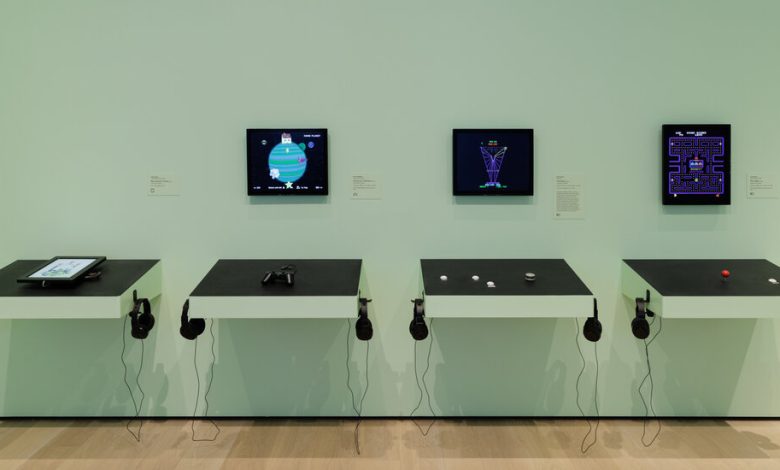Video Games at MoMA: Do They Belong There?

When the Museum of Modern Art began collecting video games a decade ago, curators boldly asserted that games were an artistic medium. Now contemporary culture is dominated by them.
The MoMA exhibition “Never Alone: Video Games and Other Interactive Design,” which runs through Sunday, represents the museum’s cautious advance into the gaming world at a time when digital culture has overtaken its galleries. Refik Anadol’s algorithmic homage to art history still twinkles in the museum lobby; an exhibition about the importance of video swallowed the sixth floor until July 8; and galleries for its permanent collection include contemporary artifacts like the Google Maps pin and a massive schematic devoted to the interlaced chain of resources needed to create an Amazon Echo as an artificial intelligence system.
However, the museum could do more to break the firewall between art lovers and game designers. After all, this is the same institution that began a film library in 1935, exhibited utilitarian toasters and cash registers as “Machine Art” in 1934 and presented modular houses in the 1950s. Curators need to unleash that same passion for games, which struggle in the current exhibition to convey the profundity, and complexity, of their designers’ thinking.
On the first floor, old computer monitors cantilevered above visitors are drawn from the museum’s collection of video games. Eleven are playable; 35 games in all are viewable. Jamming buttons on their keyboards, users were hard-pressed to crane their necks to see the flickering displays above them — a series of digital experiments from the 1990s by John Maeda, a graphic designer who now serves as Microsoft’s vice president of design and artificial intelligence.
MoMA’s standards for assessing the cultural importance of video games require an upgrade worthy of the medium, whose revenue is projected to reach $385 billion in 2023 and technologies contribute to the ongoing A.I. revolution.
For the curators Paola Antonelli and Paul Galloway, gaming is a psychological act that has defined an era when many of our relationships are mediated through screens.
And the vision of designers like Will Wright is letting players choose what lessons they want to learn — or nothing at all. One player might experience Wright’s most popular game, The Sims (included in the MoMA exhibition), as a gateway into the worlds of architecture and interior decorating; another might focus on its family-planning aspect or its staging of murder mysteries and ghost encounters.
The decision to allow games into the museum has been debated since the 2010s, when critics like Roger Ebert and Jonathan Jones declared that the medium would never rise to the status of art.
“Chess is a great game, but even the finest chess player in the world isn’t an artist,” Jones opined in The Guardian, “She is a chess player.”
At the center of these critiques was a belief that playtime belonged to children. A similar logic harmed performance art until museums started making the genre a staple in their programming, coincidentally, around the same time that MoMA started collecting games.
“People want to be taken to a new place,” Donna De Salvo, a Whitney Museum curator said of performance art in 2012 during an interview with The New York Times. “In the age of the digital and the virtual and the mediated experience, there is something very visceral about watching live performance.”
The same could be said for gaming, which embraces immersion by allowing players into their virtual worlds with the touch of a controller. The simplicity of that relationship is evident in the exhibition “Never Alone,” where Zen games like Flower ask players to weave petals through the wind on a journey across an imaginary landscape. But the concept flows through the veins of modern gaming, ever since Super Mario 64 tasked players with jumping into paintings stored within a museum-like castle to progress through its story.
So what prevents museums from developing more ambitious programming around games? And why has a serious institution like MoMA not staged the first major retrospective of a video game designer when it has enough material for obvious picks like Will Wright or Shigeru Miyamoto?
There are a few practical reasons. Designers rarely own rights to their creations, which are held by the publishers financing their games. In an interview, Antonelli singled out other hurdles: legal negotiations, lost source codes and obsolete technology that challenge the acquisition process. And then there are the headaches involved with hard wiring all those electronic systems in the galleries.
Yet there seems no better time for MoMA’s curators to show why gaming belongs in their museum and to help visitors to understand the difference between what is scholarship and what is for sale at the Nintendo store a few blocks down the street.
Never Alone: Video Games and Other Interactive Design
Through Sunday at the Museum of Modern Art, 11 West 53rd Street, moma.org.



